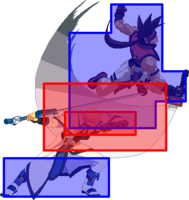Air vs Ground in a nutshell
- Posted by Chris Schiff
- Posted on July 10, 2015
- Fundamentals
- No Comments.
Whenever you see the arena in any 2D fighting game, you may notice the great amount of negative space above the 2 grounded fighters but below the life bars and timer. Up to this point, you’ve spent most of your time and energy focusing on what happens on the ground, but what about the air? Using the air as an extra avenue for combat is not nearly as important as a solid ground game, but it is still something worth diving deeper into. Please note that I will specifically be using Super Street Fighter II Turbo (ST) and King of Fighters (KOF) as examples for the duration of this article. Other fighting games give their characters a plethora of air options to make jumping a safer endeavor, but it’s important to understand how to use the air in games that don’t have these “crutches”.
In ST, once you jump, you are committed to that predetermined jump arc. You can jump straight up, backwards, or forwards, and, for any given character in the game, you only get one iteration of each type of jump. Furthermore, you cannot block in the air. All you can do is attack. Let that sink in for a moment. As the saying goes, the 1st rule of learning Street Fighter is don’t jump. Don’t take this statement word-for-word and just never jump; all it really means is that absolute beginners shouldn’t jump because they need to learn the ground game and that more experienced (but not necessarily better) players should be militant in when they choose a time to jump.
It’s worth noting that in the KOF series, every character can perform a smaller jump known as a hop. Hops do not travel as high or as far as regular jumps, so they are active for a much shorter period of time, thus making them less risky. This important universal tool makes jump-ins better than they would be in ST, but it’s still important to establish a good ground game before trying to aggressively mix up hop attacks with lows. In other words, extra aerial options in any fighting game help make jump-ins less risky, but they don’t make jump-ins 100% immune to anti-airs. I will expand upon this concept later when I talk about special game mechanics, but, for now, you should just treat jumping as an inherently risky tool.
Having established that you cannot block while jumping (at the very least, you can’t block while performing a jump-in), a grounded fighter is free to hit the air-born opponent out of the air to turn the tide of the match to his favor. When this grounded fighter attacks, the specific moves he uses are called anti-airs. Unlike regular footsies tools, these attacks are angled upward so that they can connect in the middle of someone else’s jumping arc. Some anti-airs have good vertical range but weak horizontal range: these are designed to hit someone who will land near you after a jump. Other anti-airs have less vertical range but more horizontal range: these, on the other hand, are great at stopping jumps from further away from the grounded fighter. The ideal anti-air also has some sort of invulnerability so it minimizes the risk of trading with jump-ins. A good example of this is the towards-punch move (known as 6P in numpad notation) in Guilty Gear, which, for most characters, has upper-body invulnerability.
Still, anti-airs aren’t all powerful. Because of their upwards trajectory, they usually make for very poor footsies tools. Remember, good footsies tools almost always have good horizontal range, so the ideal move to counter an anti-air is a low-hitting move with this type of horizontal range. Sometimes, if the anti-air has a whiff animation that is long enough, a sweep is preferred because it knocks down. However, most lows require you to crouch, so they lose to jump-ins because all air-born normal must be blocked high (these moves are known as overheads).
To reiterate, anti-airs beat jump-ins since they have better priority and have considerably lower risk. Next, lows beat anti-airs by whiff-punishing just like in regular footsies. To make things come full circle, jump-ins beat lows by sheer virtue of the fact that they hit overhead.
Now, we’ve covered all 4 of the basic RPS-type chains that exist in 2d-fighting games. Unlike actual RPS, though, there’s more to these chains than mere guesses and reads. To understand how to better approach each of these, you must investigate risk versus reward, but that’s another topic for another day.
Our next 2 weekly articles will discuss concepts that are more abstract but are just as essential. Next week, we will examine space control, which is closely related to (but is not identical to) footsies. The week after, we will take a look at the concept of mixups or okizeme, which is closely related to rushdown.
Supplemental 1: Anti-airing in ST
Supplemental 2: The Beginner’s Incomplete Guide to KOF
Image Source: Dustloop wiki
Recent Posts
- Spacing (Part 2): Projectiles 101
- Spacing (Part 1): When and Where to Attack
- Air vs Ground in a nutshell
- Ogawa’s Eddie: Rushdown Applied in a Real Match
- Rushdown: Keeping the Advantage
Recent Comments
- Chris Schiff on Rushdown: Keeping the Advantage
- /x\FuddyDuddyKid@Sch001/x\ on Rushdown: Keeping the Advantage

